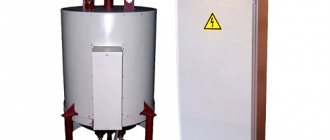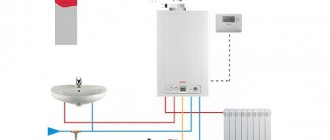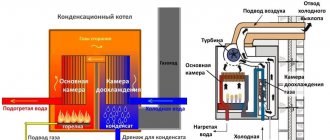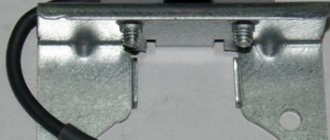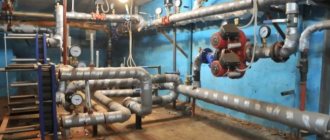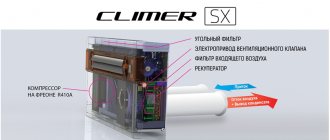Agree that a rosette is generally not the most important decoration of a room, and therefore you should not focus on it and place it in a conspicuous place. Of course, the location of the outlet for the air conditioner does not greatly affect the overall interior of the room, but it should be carefully thought out so as not to cut the wall in the future and not to use extension cords again.
We will tell you about where to install air conditioning sockets. We will show you the best and safest places to place a power point. The article also provides recommendations for masking sockets and cords from climatic technology.
Features of sockets for air conditioner
The installation of a conventional domestic air conditioner allows the use of standard power outlets. Most of the factory-fitted air conditioners have plugs and cords, but all the same, climatic equipment is not a TV or refrigerator, so you need to take care of arranging electrical lines for it in advance.
Such equipment belongs to powerful technical devices that consume a large amount of electricity during operation.
Because of this, you cannot connect other energy-intensive equipment to the same outlet with an air conditioner. Correctly performed electrical installation when connecting climatic equipment to the network is a guarantee of long-term and efficient operation of these devices.

Professional development of a design project involves determining the location of the outlet for HVAC equipment in the room, regardless of its purpose
Each air conditioner has its own indicator of the rated power consumption. This value must be taken into account when installing the device in order to minimize the risk of an accident and ensure the normal power supply of the equipment. It is indicated in the data sheet of the device. But when laying wiring lines and sockets, it is better to take indicators slightly higher.
Typical power ratings for a non-production air conditioner typically range from 800 to 1800 watts. The exact value depends on the type of climatic equipment and the area of the refrigerated room. In most cases, a simple wall outlet with a rated load of about 16A will suffice for such equipment.


Before installing the outlet for the air conditioner, you should familiarize yourself with the main characteristics of the climatic equipment specified in the technical passport of the device.
But for split systems designed to cool huge areas, such an outlet will not work, since it will not be able to withstand the load. For powerful equipment, the sockets are selected individually, depending on the power parameters of the device.
It is best to buy euro sockets to connect climatic equipment. They perfectly cope with high loads and have a long service life. The most reliable euro sockets include products of the brands ABB, Legrand, Siemens, GIRA, etc.
Motor connection instructions
Now let's take a closer look at how to properly connect the motor of a household air conditioner. So, manufacturers of household air conditioners provide the most convenient option for connecting equipment to the power supply network. Moreover, a simplified connection diagram is provided for both single-phase and three-phase networks.
It is not necessary to directly connect the air fan of the outdoor unit of the air conditioner. It is enough to connect the common (main) power supply and commutation cable to a special terminal.But first, we recommend that you figure out how to choose and install a vending machine on an air conditioner.


View of the contact terminal for connecting the air conditioning system after the open protective cover. In this case, a three-phase connection is demonstrated, which is not often used in everyday life.
To figure out how to properly connect the electric motor from the air conditioner to the power network and understand the intricacies of connecting the conductors on the switching terminal, consider the electrical circuit of one of the devices.
Wiring diagrams for connecting household air conditioning units have minor differences. Any manufacturer of this kind of machine is interested in competition even in terms of the convenience (simplicity) of the electrical connection.
Stage # 1 - connecting the outdoor unit
An important detail should be noted right away: the electrical circuit for switching modules and connecting to the mains is always present on the back of the protective terminal cover.
In any case, well-known manufacturing firms adhere to this practice. In addition, the electrical connection diagram is always included in the device documentation.
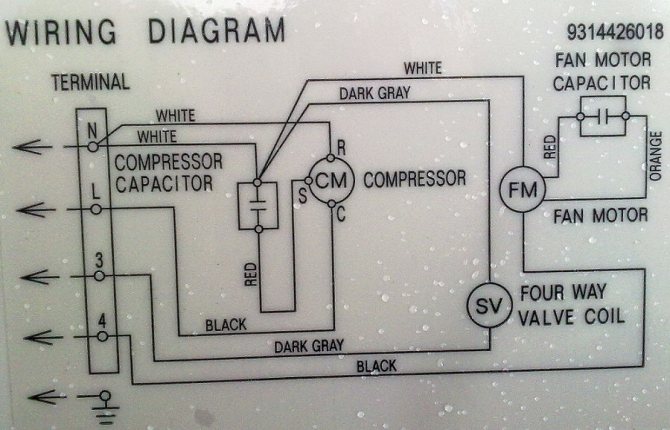

Example of wiring diagram on the terminal cover of an outdoor unit for a domestic air conditioning system. Here is a single-phase version, where the terminals are connected to the terminal: N - neutral (zero); L - phase; 3, 4 - terminals of conductors for interfacing with the indoor unit; also on the diagram there is a "ground" contactor
In the above connection diagram, you can clearly see the presence of two electric motors present in the outdoor (outdoor) module.
This, respectively, compressor motor (CM) and condenser fan motor (FM). Schematically, the power lines of both electric motors are commutated and brought out to the terminal.
Stage # 2 - connecting the indoor unit
The split system module, designed for indoor installation, also has a switching terminal through which electrical communication with the outdoor module is carried out. Power is supplied to the indoor unit via the same terminal.


Example of location of a breakout terminal for an indoor air conditioning module. It should be noted - for products of different companies, the design and location may differ slightly.
Usually, in the simplest version, a signal pair of conductors is connected to the terminal of the indoor module, as well as:
- phase;
- null;
- grounding.
Again, depending on the design of a particular brand's A / C system, the electrical connection configuration may look different.
Therefore, you should always carefully read the technical documentation before proceeding with the installation work.
Stage # 3 - connecting two system modules
So, let's assume that both modules of the air conditioning system are mounted inside and outside the building - fixed on the wall panels:
- a refrigerant circulation line is laid between the modules, consisting of two copper pipes of different cross-sections;
- main pipes are insulated and secured;
- the end points of the main pipes are connected to the modules accordingly;
- the installed line is checked for tightness with a time delay.
After completing such a sequence of operations with the newly installed household air conditioner, you can already start organizing electrical communication between the modules with subsequent connection directly to the power supply. One of the possible options for connecting blocks is shown in the diagram below.


A variant of a schematic diagram showing the integration of individual modules of a household air conditioning system into a single electrical system.But this example, unfortunately, is not applicable to all models of split systems without exception.
Actually, as can be seen from the above configuration of combining modules with each other, there are no special difficulties in the work for the user. Just follow the numbering (or designation) of the terminals when making connections between the terminals of the indoor and outdoor units.
That is, if an electric wire is connected to the terminal marked “1” on the outdoor unit, the same wire is also connected to the terminal “1” on the indoor unit, and so on.
Of course, the execution of electrical interconnects, as well as connections to the supply network, must be done taking into account the correct selection of the conductor cross-section. The permissible cross sections are usually indicated in the documentation for the device in the same section where the circuit diagram is presented.
We also recommend that you familiarize yourself with the specifics of choosing a place for installing an outlet for an air conditioner.
Where is the best place to install the outlet?
Air conditioning cords can be up to a meter in length, and therefore it is necessary to plan the location of the outlet in such a way as to exclude the possibility of sagging of the wires. If, when installing the air conditioner, no electrical work is planned, you will have to dodge: spoil the decoration of the room or try to use existing connectors.
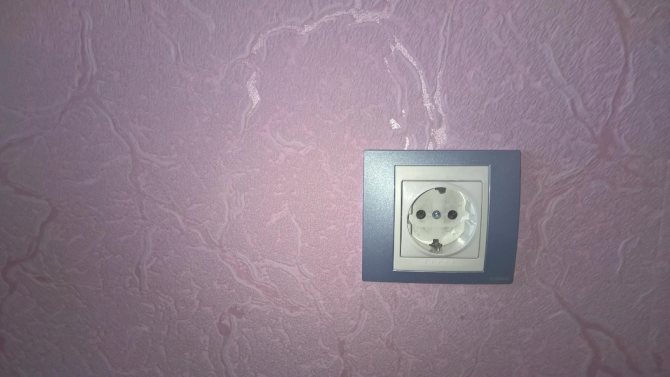

The electrical outlet for a domestic air conditioner is of standard dimensions, but its location in a residential or commercial space must be determined in advance
When installing a simple household air conditioner in an ordinary apartment, few people think about the location of the outlet for the split system. The device is connected to the nearest 220V outlet through an adapter, with a wire extension or directly (depending on the location of the outlet point of the power network).
But such a connection is only suitable for non-inverter models with a capacity of less than 4 kW. Also, if a certain phase orientation is observed, this method can be used to connect low-power inverter-type climate systems.
It is best to install a new outlet for the air conditioner. Even if the existing outlet can perfectly cope with the load from the electrical appliance, the hanging wires will look unaesthetic, although in the apartments they do not make the outlet points of the network under the ceiling.
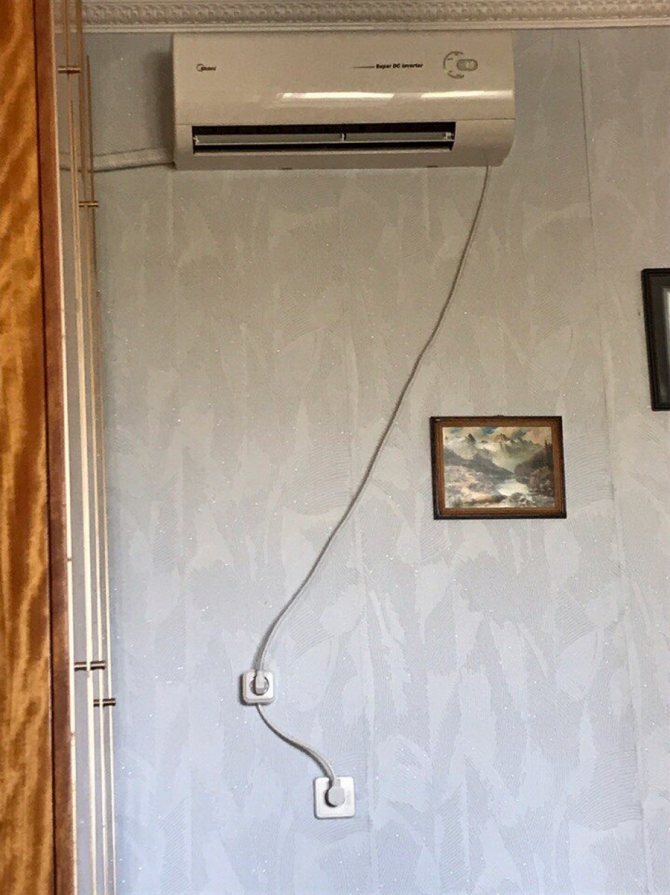

Dangling wires from a household air conditioner can ruin the entire interior of a living space, because they make the room look untidy
When designing and installing climatic equipment, it is worth “hiding” the socket between the air conditioner case and the nearest wall so that it looks as harmonious as possible.
If this is not possible, it can be installed under or to the side of the device (not on the side of an adjacent wall). It is not worth mounting the outlet above the equipment, because in this case you will have to hang the air conditioner slightly lower.
General rules when choosing a place for an outlet
When choosing a place for mounting an individual outlet, you need to take into account the power of the climatic equipment, the location of other technical devices in the room, the thickness of the section of the electrical wiring and the specifics of the layout of the room.
Appliances and furniture should not become an obstacle to connecting a household air conditioner to an outlet. Also, you should not put plants and flowers in front of the outlet, because they often have to be watered, and therefore there is a risk of accidental spillage of water and getting it into the socket.
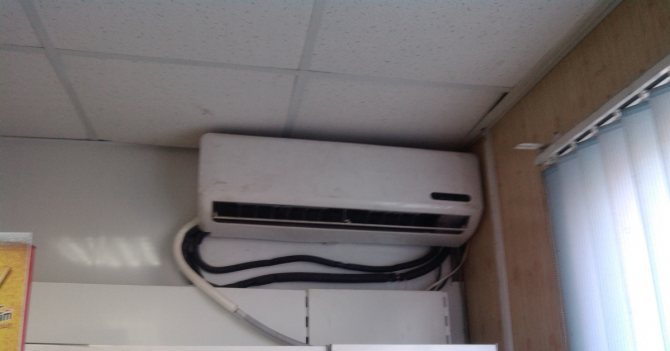

The cord from the air conditioner to the outlet should not go around paintings, wall clocks, shelves and various interior items
It is forbidden to mount the socket next to gas pipelines. Ideally, the distance between the gas pipes and the electrical outlet should be at least half a meter.
In addition to these parameters, other factors must be taken into account:
- the total load on the selected power line, taking into account all connected electrical appliances;
- the ability to change the cable routing scheme;
- the presence of an overload machine in the house, etc.
The air conditioner cord most often has a length of up to a meter, so the socket must be installed as close to the device as possible (ideally, it should be located at the level of the device body mounting). After all, otherwise you will have to pull the extension cords across the entire room, which can negatively affect the interior.
In addition, extension cords and adapters are unnecessary connections and additional contacts, therefore, manufacturers of climatic equipment recommend avoiding such a multi-stage connection.
Because of this, the distance from the ceiling to the electrical outlet is usually less than 30 cm, since the air conditioner itself is fixed high above the ceiling. In this case, the distance between the outlet and the ceiling should not be less than 15 cm.
But there are exceptions to any rule. For example, if a very wide molding (ceiling plinth) is installed in the room, then the outlet will have to be lowered below the ceiling.
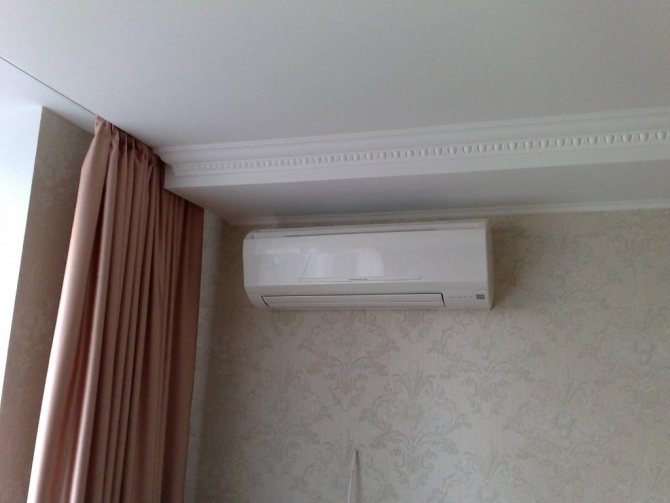

When installing sockets for air conditioning equipment, it is necessary to take into account the design features of the room in which the air conditioning equipment is installed
If the outlet cannot be installed under the ceiling, and it is mounted at the bottom of the wall, then you should not install it too low either. The ease of use of the room depends on the height at which the outlet for the air conditioner is located from the floor.
Experts advise to do it at a height of 10-15 cm, because then when washing the floor, water will not enter the connector. But in most cases, the sockets in the apartment are located much higher.
According to the European standard, they are installed at a height of 30 cm from the floor, and according to the Russian standard (it remained from Soviet times) - 90 cm.The distance between the outlet and the window slope should be at least 10 cm, and between the outlet and the nearest wall should be be at least 20 cm.
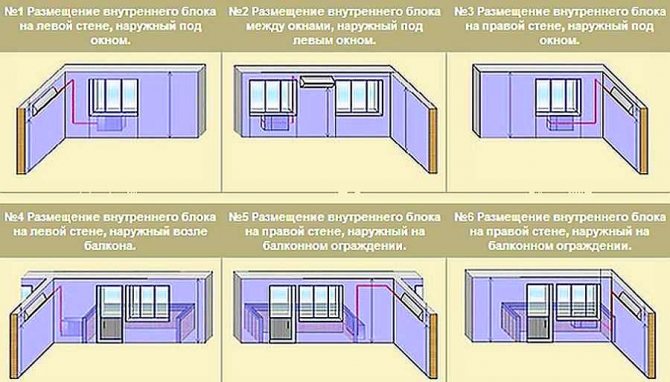

Before installing the domestic air conditioner, electrical wiring and standard outlet, measurements should be taken in the room and on the plan
All grounded metal elements (batteries, heating pipes, water pipes, etc.) must be located at a distance of at least 50 cm from the outlet of the electrical network. Also, the electrical wire is additionally protected from heating pipes with insulation.
High power industrial models are directly connected to the switchboard. For this, an additional cable is laid in the room. Also, the outdoor unit of split systems is connected directly to the electrical panel. The indoor unit cord can be plugged into a regular indoor outlet.
The presence of a separate line and a separate machine when connecting climatic equipment has several advantages:
- In the event of a breakdown of the air conditioner and a short circuit on the line, the rest of the electrical appliances will work in standard mode.
- If there is a separate line, you can install an air conditioner of any capacity without calculating the total load on the wiring.
- The presence of a separate line makes it possible to install additional differential protection and control system. This is true in the case that the outdoor unit of the air conditioner is accessible for touching.
Regardless of where the AC outlet is installed, it must be grounded or a differential relay. Grounding is an artificially created contact between an electrical device and the ground, due to which the voltage of an electrical installation is reduced.
Lack of grounding can lead to a potential on the case and on all metal parts of the air conditioner at half the phase voltage due to the presence of a power filter. Manufacturers of any climatic equipment indicate in the passport the presence of mandatory grounding, so they should not be neglected.
Also, all electrical wires from the outlet must be suitable for the load. It is best to choose reliable copper three-core wires in white, blue and yellow-green (phase, zero and ground), since aluminum has a lower electrical conductivity. If the socket has aluminum wires, it is better to replace them with copper wires.


When connecting aluminum and copper wires, twists should be avoided due to the high risk of fire in the places of their connection
It is best to take wires with a cross section of about 2.5 mm2. If the cross-section of the wires is too small, they will not withstand the load.
How the fan of a domestic air conditioner should work
In a simplified form, the fan design is an impeller mounted on the shaft of an electric motor, which drives it into rotation. Depending on the installation location and the function performed, the shape of the blades and the features of operation may differ. Considering that the overwhelming majority of domestic air conditioners for residential premises are a split system consisting of an indoor and outdoor unit, the scheme of its operation provides for the presence of a fan in each of the units.
Indoor unit fan design and functions
The principle of operation of all air conditioning systems is based on the physical properties of a liquid to take heat during evaporation and give off heat during condensation. In split systems, a refrigerant, freon, is used as a coolant, which boils and evaporates at room temperature. The indoor unit contains a special device - an evaporator. Passing through it, warm air from the room cools down and returns back in the form of cold air. Another important element of the indoor unit of the air conditioner is the fan, which provides forced circulation through the heat exchanger.
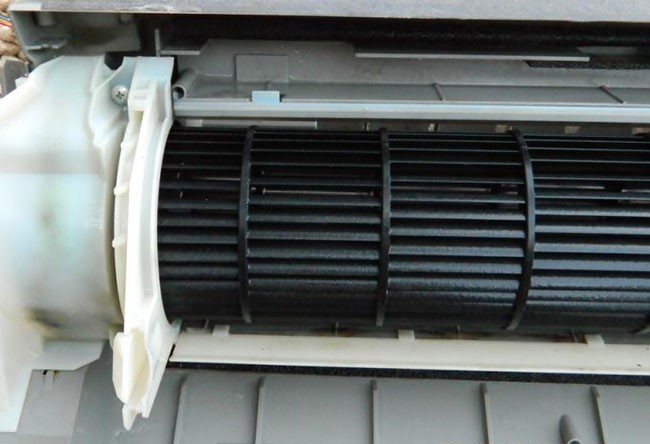

Indoor unit fan
The diagonal fan of the indoor unit has the shape of a hollow cylinder, on the walls of which the impeller elements are located. The evaporator, as it were, bends around it, providing warm air intake from the front and top sides of the unit. The cooled air passing through the fan and diffuser is fed back into the room. The control elements inside the block ensure the switching on and off of the electric motor, as well as changing the speed of its rotation. Diagonal fans are fairly reliable devices with compact dimensions and low noise levels, but their main drawback is the inability to overcome significant obstacles to the air flow, for example, when the filter is clogged.
Outdoor fan design and function
If the indoor unit serves to evaporate refrigerant, then the opposite process occurs in the outdoor unit - freon condenses, and the resulting heat is removed to the atmosphere. For this, the air conditioner is equipped with a special device - a compressor, which creates a high pressure required for the rapid transition of gas into a liquid state. The condensation process takes place in a heat exchanger in the form of a radiator, and is accompanied by the release of heat. The fan of the outdoor unit has a standard shape with large blades, thanks to which it is possible to quickly dissipate heat outside and protect all elements of the unit, including the compressor, from overheating.


Outdoor unit fan
Connecting the air conditioner to the network
Before connecting the split system to the mains, you should familiarize yourself with the diagrams and specifications for the unit's units and analyze the composition of the walls. Then you need to inspect the existing power supply system, measure the cross-section of the incoming cables and test the selected route with a special detector.
There are several ways to connect the air conditioner to the mains. If the wiring line for a powerful electrical appliance was not provided in advance, you will have to lay networks and install sockets after overhaul.
The most convenient way is to connect the socket in the junction box of the room. But this becomes possible only if the electrical wiring from this box to the electrical panel of an apartment or private house can withstand the maximum possible load of all connected electrical appliances.
Another method involves laying new wiring lines. In this case, you need to grind the wall, lay a new cable in a plastic corrugated pipe and connect it to the junction box. If the depth of the strobe is more than 2 cm, the cable can be hidden in the wall without a corrugated tube.


A corrugated pipe (corrugated pipe) is a pipe with a variable cross-section, in which there are thick-walled and thin-walled sections that give it rigidity and flexibility at the same time
The strobe can run horizontally or vertically, but it cannot be located diagonally. This is contrary to the basic building regulations.
On the basis of the project for the arrangement of lines, it is possible to determine in advance the places for the outlet of the electrical network, incl. and for climatic technology. If it is not possible to cut the wall, the electrical wiring can be laid in an open way.
In this case, the wires are hidden in a special plastic cable channel, which is fixed to the wall with screws. This method is the least time consuming and costly, but the plastic channel can disrupt the appearance of the room.
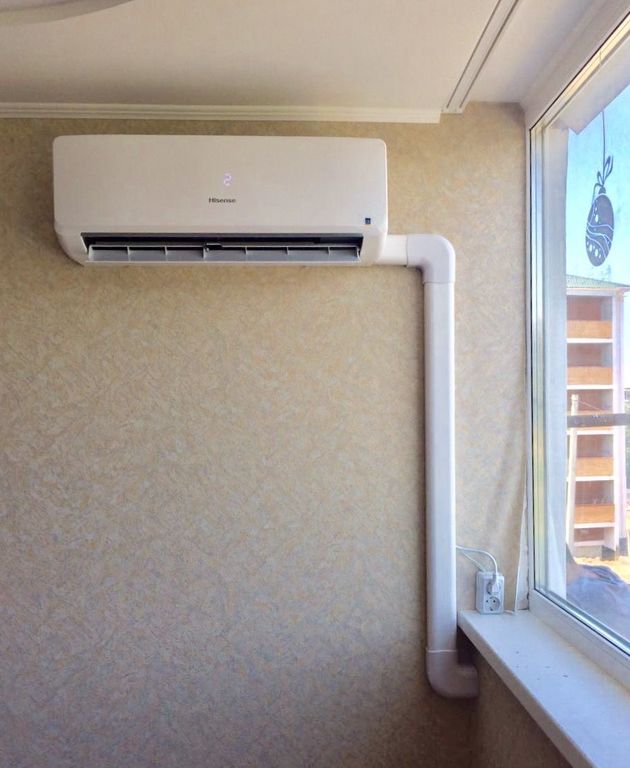

You can hide the cord from the household air conditioner to the power outlet in a plastic box of any color and shape, depending on the features of the room interior
If none of these methods work, you can daisy-chain the device to an outlet that supplies a lower-wattage appliance. In this case, the loop stretches from the socket next to the air conditioner to the very point of power supply. But you need to check the capabilities of the outlet. If the network cannot handle the load, the wires will burn out.
Connecting the split system to the power supply using a plug and a previously installed socket is the easiest way. To do this, you do not need to perform electrical work, so any person can handle such a connection.
This mounting option is chosen for:
- split systems of low power (up to 4 kW);
- air conditioners built into the window;
- air conditioners that were installed in the room for a short time.
But it is better to work out the location of climatic equipment and sockets for it in advance. This will allow you to lay more reliable wires to the outlets from which the air conditioner will be powered in the future.
General recommendations
The electrical circuit of an air conditioner for consumer services differs from the connection of a three-phase device, which is used in large offices for various purposes, business centers, and supermarkets.
It must be remembered that electrical installation is carried out in accordance with the Rules for the Installation of Installations and the relevant regulations.
Carefully prepare for connecting the units to the mains. To do this, you should:
- carefully read the diagrams and specifications for the components and materials of the device;
- inspect the existing power supply system, including the location and cross-section of incoming cables;
- test the intended track with a detector for the absence of internal wiring and metal elements of building structures;
- analyze the composition of the walls, on the surface or inside which electrical work will be performed.
Connection of the air conditioning system is impossible if there is old aluminum wiring in the house and there is no grounding.
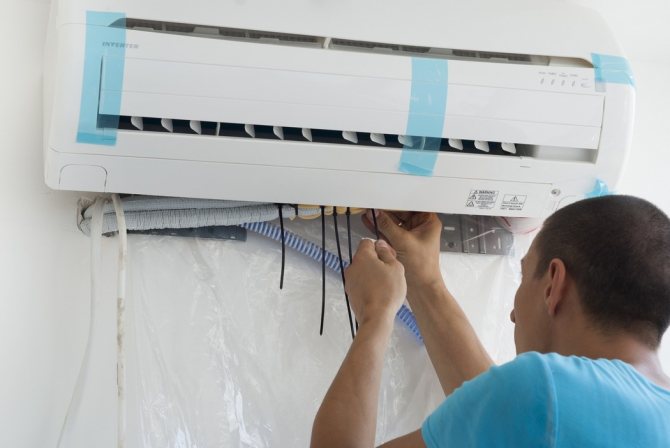

Direct cable routing must comply with the following requirements:
- a distribution box, a switch, a socket for a household air conditioner are located in an accessible place;
- the socket is installed at a distance of at least 50 cm from the floor and grounded metal elements (batteries, water and heat supply pipes);
- the wire is laid only horizontally and vertically;
- when laying horizontally, retreat:
- from the cornice 5-10 cm,
- from the ceiling - 15 cm,
- from the plinth - 15-20 cm;
- there must be at least 10 cm between the vertically stretched wire and the corners, as well as window and door openings;
- laying parallel to gas pipes is carried out at a distance of 1 m from them;
- the electric wire is protected from heating pipes with insulation.
In addition, the following rules for connecting devices to the mains must be observed:
- It is strictly forbidden to connect the wires by twisting. Build-up is done using terminal blocks or bolts;
- it is not allowed to connect a wire made of aluminum and copper due to their different electrical conductivity (for a copper cable, this figure is one and a half times more).
External wiring
If the method of laying on the wall surface is chosen, then the cables are fixed every 50-60 cm with plastic clamps, which in turn are fixed on the wall with screws. When using boxes in which the wire is laid, they are fixed with glue or screws.
Internal wiring
Cables hidden in the wall are laid in plastic corrugated pipes, after making a recess (groove) of the required length. Usually the corrugated pipe is fixed inside the wall with clamps. If the depth of the groove is 2 cm or more, then it is allowed to perform work without a corrugated pipe.
It is forbidden to lay wires in bundles and at a distance of less than 3 mm from each other.
How to hide the socket of a split system?
The sockets for the air conditioner are usually visible. They do not need to be forced with furniture or appliances, but sometimes they can violate the overall design concept of the entire room.
This even applies to modern flat sockets, which only slightly protrude on the wall, which is to say about the usual "pot-bellied" models. In this case, designers go for small tricks and mask the sockets in the most unusual ways.
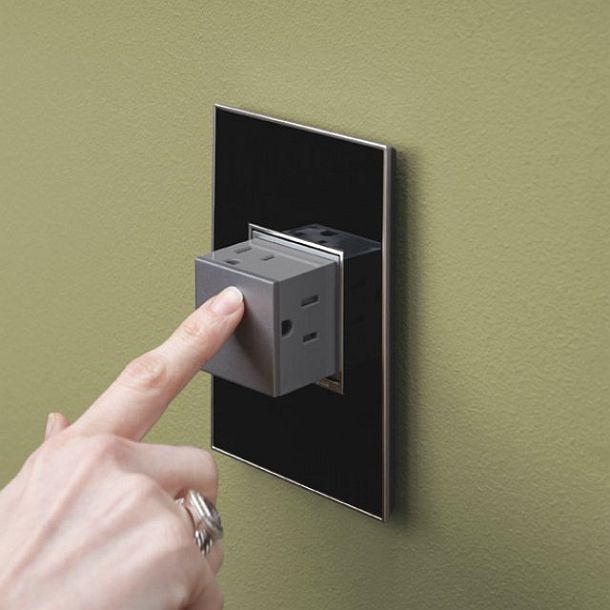

Spectacular retractable sockets are ideal for living spaces made in a modern style (hi-tech, modern, gothic, etc.)
For example, the socket is mounted in a shelf on which the climatic equipment stands, is hidden in a three-dimensional picture next to the air conditioner, or is made in the form of a block that slides out of the wall when pressed. The latter option is suitable if the air conditioner will only occasionally be connected to the power supply.
Also, sockets with covers (hinged and retractable) are produced today. These covers can be additionally decorated, painted in a bright color or made as invisible as possible.


The shelf next to the air conditioner, in which the electrical outlet is hidden, can also be used for its intended purpose, i.e. you can put books or figurines on it
If there is a closet next to the air conditioner, then the outlet can be hidden in it and arranged in the form of a retractable unit (top, bottom or side). It can also be closed with a false panel or cornice.
If the climatic equipment has too long a cord, then it, together with the outlet, can be masked using a non-standard volumetric drywall block made in the same interior style.
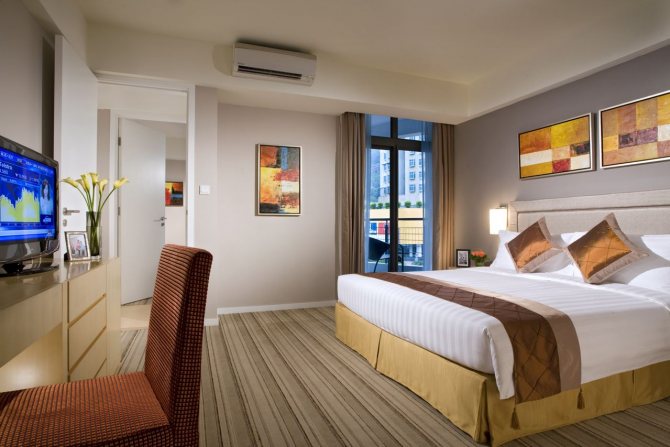

Installing an unusual painting near the air conditioner in a bedroom, hallway or living room allows you to refresh the interior of any living space
There are also other ways to mask outlets today. They can be closed in a small cabinet with sliding doors or covered with a folding mirror. If the style of the interior allows, the connector can be placed behind a small decorative door. Such a solution will be interesting to look in interiors in country style, Provence, chalet, etc.
The rosette can be covered with artificial flowers. In a bedroom or living room, you can use a print, stained glass panel or drawing to mask the connector to make it look part of the design composition.
In the children's room, an electrical outlet can be hidden behind a retractable multi-colored panel, an interactive map or any three-dimensional models. For example, if a child is fond of Star Wars, then you can hide the connector behind a plastic model of the Death Star or Millennium Falcon.


You can hide the outlet for the air conditioner in a mini-locker in the living room, in the corridor, in the bedroom, and in the children's room.
Usually, the sockets for the air conditioner are hidden in the same way as the sockets for other household appliances in the room. The choice of this or that masking method depends on the design features of the room. But today some architects propose not to hide the sockets and wiring to the air conditioner, but to make them as open as possible.
Moreover, the design concept provides for the use of wires of contrasting colors (for example, on a white wall, fix black wires almost in the central part of the wall). If the wiring of the air conditioner is open, then there will be no point in installing a hidden outlet, and this detail can be made bright.
When the air conditioner cannot be plugged into the outlet?
The climatic equipment can be connected to the household network both in the apartment and in a country house, but for this certain conditions must be met. Otherwise, there is a risk of an emergency.
So, it is forbidden to connect air conditioners to the outlet if:
- there is no good grounding;
- the electrical wiring is in poor condition (for example, there is only old-style aluminum wiring in the room, which will not be able to withstand the load from the air conditioner);
- there are no devices that equalize voltage drops (this is especially dangerous in houses with wooden floors);
- the cable has insufficient cross-section for connection, etc.
HVAC equipment requires proper electrical wiring. It is sensitive to voltage surges and can become unusable in the event of any problems on the power line.
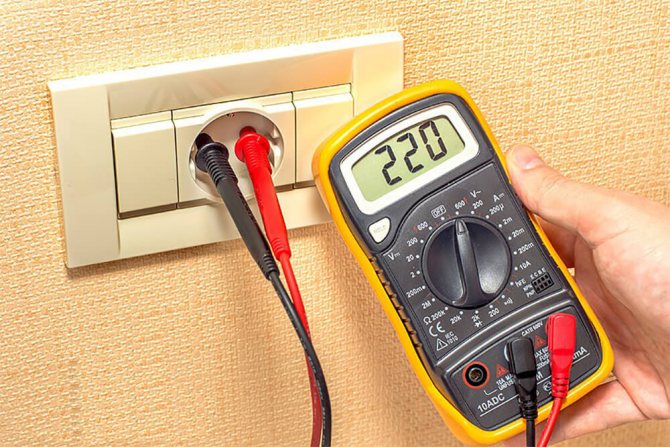

Before installing and connecting the household air conditioner to the network, you need to check the operation of the electrical outlet using a special tester
You can check the performance of the outlet at home. To do this, you just need to buy a tester and read its instructions.
How to connect a fan from an air conditioner
Hello everyone!
As I already wrote, some measures were taken with the air conditioning system in Pravda. www.drive2.ru/l/505017236583350389/ In the company of the fan, I installed a relay block + freon pressure sensor.
And he waited by the sea for the weather, or rather the activation in automatic fan mode. Shish with butter, not a job!
Here I am a sucker - panties in peas!
Not only that I still do not have an ABC book, but also I have forgotten how to understand the schemes. If, of course, you can unlearn what you did not know before))))) In short, I freaked out and went today to my acquaintance electrician-electronics engineer. I set the task to force the button, also with a cut from Denis.
Now, under the code name REAR COOL, I have a cooler valve. And after 30-40 minutes I received the finished product. Everything I wanted. When pressed, the ON indication lights up. When disabled, acc. goes out. When the dimensions (light) are turned on, the indication dies out, but the button icon itself is displayed.
Eventually
: - time and money were wasted on replacing the sensor and released freon, although refueling costs a thousand, and a full refueling of 1.5 is not at all in vain - for the purchase and installation of a fan and relay (they were useful for mounting a circuit through a button).
Cold
that comes from the air ducts
tangibly
frosty than without a fan, and
very
colder than it was before installing the fan and before refilling. Now there is confidence that climate control will be fully utilized. Plus, in which case, I think this fan can be successfully used in the general case of cooling the main radiator.Along the way, I cleaned the radiator with a cleaner through the drain pipe. In my opinion, he threw the money down the drain. But what's done is done. There was a lot of dirt from the drainage, but I don't consider it a real cleaning. He acted according to the instructions on the can.
Tomorrow I will write willy, whose advice and comments were useful to me, but for today it is enough. It's time for a pillow kingdom - a blanket state.
All peace, kindness and sweet dreams
- it has been proven that there is no caries from them.
